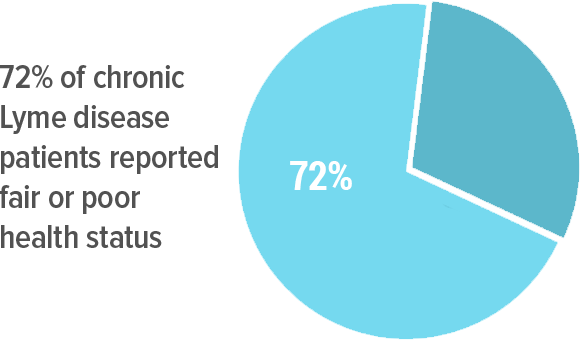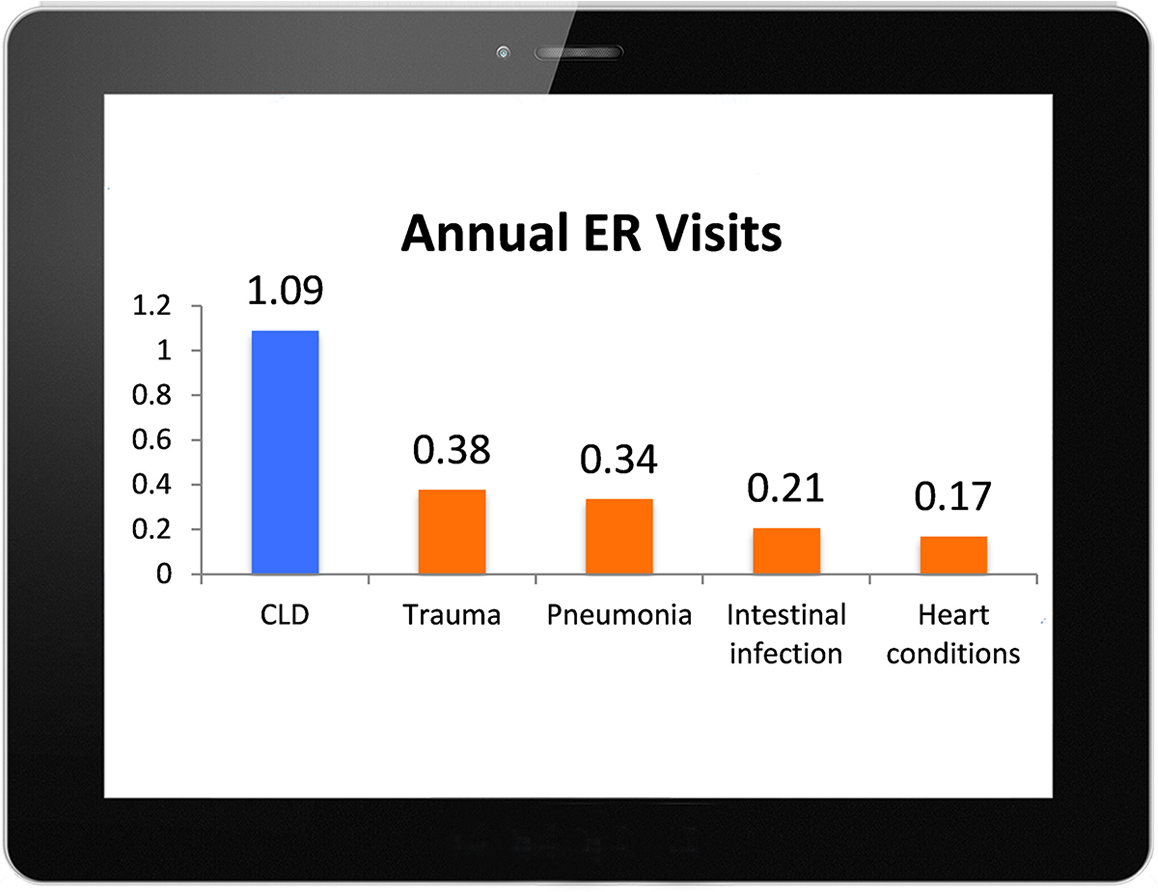Chronic Lyme disease Quality of Life Survey
Severity of chronic Lyme disease (CLD) compared to other chronic conditions: a quality of life study.

This study was conducted by LymeDisease.org over the internet during the course of a year beginning in February 2013. It is published in a peer-reviewed journal, which is available open access.
Chronic medical conditions may be characterized by time course, pathogenesis, symptom patterns, late stage manifestations, functional impairment or activity limitation, clinical severity, and management burden on caregivers and society). These conditions come with varying levels of severity. While some diseases are highly disabling, others are not. This variability makes comparison between diseases problematic. Use of the CDC HRQoL metric provides the opportunity to compare the health status of CLD patients to that of the general population and patients with other chronic diseases despite the variability of these conditions.







The purpose of this study was to document the severity of chronic Lyme disease (CLD) compared to other chronic conditions using the Health Related Quality of Life HRQoL 9-item metric developed by the Centers for Diseases Control. The study also examined healthcare utilization rates and employment and productivity losses in patients with CLD.
The CDC HRQOL self-assessed health status measures how individual perceive their health, which is rated as excellent, good, fair or poor. 72% of CLD patients reported fair or poor health status, compared to 16% of the general population. This frequency significantly exceeds that of other chronic diseases, with congestive heart failure (62%)) and fibromyalgia (59%) being the closest. Only 23% of those with Lyme disease for less than six months reported their healthcare status as poor, compared with 56% at one year and 72% at 5–10 years. The poor health status conforms with the severity of symptoms reported, their high healthcare utilization, and the loss of work productivity in CLD patients.
The list of symptoms used in the symptom severity questions were drawn from a review of Lyme research as well as a small online survey that pilot-tested survey questions for a previous study of 2,424 patients regarding access to care. Chronic Lyme patients reported an average of 3 severe or very severe symptoms, with 13% reporting at least one symptom and 63% reporting two or more symptoms as severe or very severe. This finding is at odds with the IDSA guidelines which view such symptoms as no more than the “aches and pains of daily living.”
Healthcare utilization was measured using the criteria employed by the Medical Expenditure Panel Survey. CLD patients report high healthcare utilization levels. Compared with the general population, CLD patients visited healthcare providers 5 times more often and emergency departments more than twice as often. They were almost twice as likely to stay overnight in a hospital and were roughly six times more likely to receive or pay for homecare visits.
Patients with CLD have more physical (20 days) and mental (16%) unhealthy days in a 30-day period compared to only 5 bad physical and 3 bad mental days in the general population. These unhealthy days exceed those of other serious diseases including chronic back pain, asthma, diabetes, and cancer.
Respondents suffered greater impairment of their ability to work compared to the general population. In March 2013, 81% of the general population ages 25–54 were employed, compared with 46% of CLD respondents in that age range. Approximately 42% of respondents reported that they stopped working as a result of Lyme disease (with 24% reporting that they received disability as a result of CLD), while 25% reported having to reduce their work hours or change the nature of their work due to Lyme disease. These figures compare with 6% of the USA population that is unable to work due to health problems and 3% that are limited in work due to health problems. Those respondents who were able to continue working reported missing 15 days of work during the preceding 240-day work year, and they reported an inability to concentrate while at work (so-called presenteeism) during 42 days of work in the preceding year due to illness.
Other findings of interest related to the high incidence of laboratory confirmed tick-borne coinfections, which were reported by 53% of CLD patients. Another unexpected finding was that the majority of patients with chronic Lyme disease are not on antibiotics. 92% of those on antibiotics were on oral antibiotics. Chronic Lyme patients who reported not taking antibiotics specified many reasons: using other treatment methods, currently well or in remission, financial constraints, no access to treating physicians, treatment no longer helping, and treatment side effects.
Compared to the general population and patients with other chronic diseases reviewed here, patients with CLD reported significantly lower health quality status, more bad mental and physical health days, a significant symptom disease burden, and greater activity limitations. They also reported impairment in their ability to work, increased utilization of healthcare services, and greater out of pocket medical costs. The heavy burden of illness associated with CLD highlights the need for earlier diagnosis and innovative treatment approaches that may reduce the burden of illness and concomitant costs posed by this illness.
Johnson L, Wilcox S, Mankoff J, Stricker RB. Severity of chronic Lyme disease compared to other chronic conditions: a quality of life survey. PeerJ. 2014; 2. Available from: https://dx.doi.org/10.7717/peerj.322.
Study Highlights
health status
72% of CLD patients reported fair or poor health status, compared to 16% of the general population. This frequency significantly exceeds that of other chronic diseases, with congestive heart failure (62%)) and fibromyalgia (59%) being the closest.
symptoms
63% of CLD patients report two or more symptoms as severe or very severe. Patients reported an average of 3 severe or very severe symptoms. The symptoms most frequently described as severe or very severe were fatigue (59%), sleep impairment (50%), and muscle/joint pain 46%.
antibiotics
53% of CLD patients report that they do not take antibiotics to treat their illness. 92% of patients on antibiotics take them orally.
tick-borne coinfections
53% of CLD patients reported having tick-borne coinfections that were confirmed by serological testing. 30% reported two or more co-infections. The most common were Babesia (32%), Bartonella (28%), and Ehrlichia (15%).
work status
42% of CLD patients have quit work and 25% have cut back on the nature of their work. This compares to 6% and 3% in the general population. Those working missed 15 days of work during the work year and were unable to concentrate 42 days.

CONTACT | MyLymeData | PRIVACY
Copyright © 2023. All Rights Reserved LymeDisease.org. Site design by CauseRoar
 72% of CLD patients reported fair or poor health status, compared to 16% of the general population. This frequency significantly exceeds that of other chronic diseases, with congestive heart failure (62%)) and fibromyalgia (59%) being the closest.
72% of CLD patients reported fair or poor health status, compared to 16% of the general population. This frequency significantly exceeds that of other chronic diseases, with congestive heart failure (62%)) and fibromyalgia (59%) being the closest. 63% of CLD patients report two or more symptoms as severe or very severe. Patients reported an average of 3 severe or very severe symptoms. The symptoms most frequently described as severe or very severe were fatigue (59%), sleep impairment (50%), and muscle/joint pain 46%.
63% of CLD patients report two or more symptoms as severe or very severe. Patients reported an average of 3 severe or very severe symptoms. The symptoms most frequently described as severe or very severe were fatigue (59%), sleep impairment (50%), and muscle/joint pain 46%. 53% of CLD patients report that they do not take antibiotics to treat their illness. 92% of patients on antibiotics take them orally.
53% of CLD patients report that they do not take antibiotics to treat their illness. 92% of patients on antibiotics take them orally. 42% of CLD patients have quit work and 25% have cut back on the nature of their work. This compares to 6% and 3% in the general population. Those working missed 15 days of work during the work year and were unable to concentrate 42 days.
42% of CLD patients have quit work and 25% have cut back on the nature of their work. This compares to 6% and 3% in the general population. Those working missed 15 days of work during the work year and were unable to concentrate 42 days.
